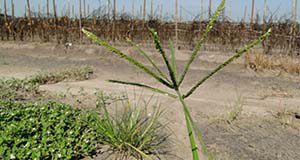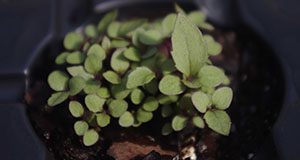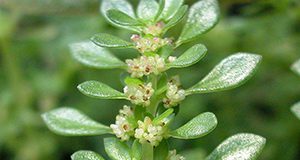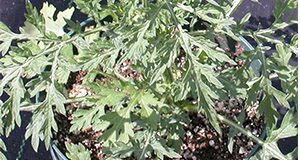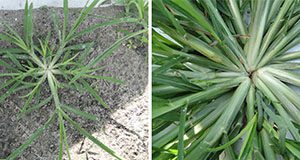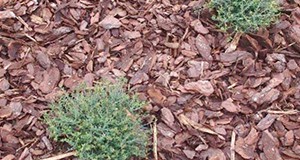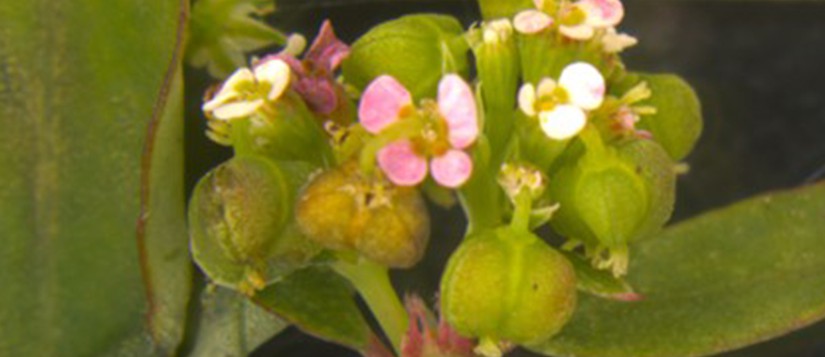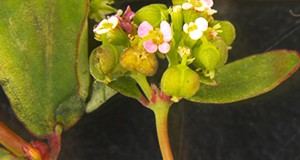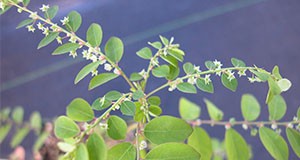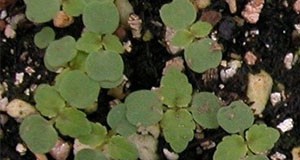This six-page fact sheet provides information about the biology and management of goosegrass, including preemergence and postemergence control options. Written by Shawn Steed, Christopher Marble, Nathan S. Boyd, Andrew MacRae, and Kiran Fnu and published by the Environmental Horticulture Department.
http://edis.ifas.ufl.edu/ep538
Tag: Chris Marble
Biology and Management of Thickhead (Crassocephalum crepidioides) in Ornamental Crop Production
Typically found in shadehouses and shaded areas of nursery production, thickhead grows aggressively in containers and can outcompete nursery crops for water, nutrients, and light. This erect, sparingly branched, herbaceous annual, grows up to 4 feet tall and germinates over a wide range of pH, salt, and temperature conditions. This four-page fact sheet describes thickhead (Crassocephalum crepidioides) and various methods for its control in ornamental crop production. Written by Allison Bechtloff, Shawn Steed, Chris Marble, and Nathan Boyd and published by the Environmental Horticulture Department.
http://edis.ifas.ufl.edu/ep534
Biology and Management of Pilea microphylla(Artillery weed) in Ornamental Crop Production
This five-page fact sheet describes the biology and management of Pilea microphylla, or artillery weed, for ornamental crop production. Artillery weed occurs primarily in moist, disturbed areas and is thought to be native to South America and parts of North America. It is found throughout Florida. Written by Debalina Saha, Chris Marble, Shawn Steed, and Nathan Boyd and published by the Environmental Horticulture Department.
http://edis.ifas.ufl.edu/ep535
Herbicidas Postemergentes para Uso en Ornamentales
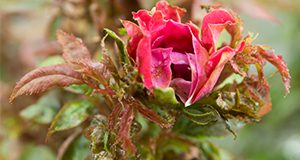
This is the Spanish language version of ENH95/WG095 Postemergent Herbicides for Use in Ornamentals http://edis.ifas.ufl.edu/wg059 Postemergent herbicides are applied directly to weeds. This 5-page fact sheet is largely comprised of two tables: Table one lists postemergent herbicides that can be safely used over the top of some ornamentals when used according to label directions; table 2 lists postemergent herbicides that are registered for use around ornamental plants when applied as a directed spray. Written by E. Vanesssa Campoverde, Chris Marble, and Jeffrey G. Norcini and published by the Environmental Horticulture Department.
http://edis.ifas.ufl.edu/ep533
Biology and Management of American Black Nightshade (Solanum americanum P. Mill.) in Tomato, Pepper, Cucurbit, and Strawberry
This three-page fact sheet describes the biology and management of American black nightshade, explaining how to control for it in tomato and pepper, cucurbits, and strawberry. Written by Nathan S. Boyd, Shawn Steed, Chris Marble, and Andrew MacRae and published by the Horticultural Sciences Department.
http://edis.ifas.ufl.edu/hs1176
Biology and Management of Ragweed Parthenium (Parthenium hysterophorous L.) in Ornamental Crop Production
This six-page fact sheet provides an overview of Ragweed Parthenium, Parthenium hysterophorous L, including a species description and information on how to manage ragweed parthenium culturally, physically, and chemically. Written by Debalina Saha, Chris Marble, Robert H. Stamps, and Shawn Steed and published by the Environmental Horticulture Department.
http://edis.ifas.ufl.edu/ep531
Biology and Management of Goosegrass (Eleusine indica (L.) Gaertn.) in Tomatoes, Peppers, Cucurbits, and Strawberries
This four-page fact sheet gives a brief description of the biology and management of goosegrass, a common annual turf and horticultural weed found throughout Florida that grows well in compact, wet soils and superficially resembles crabgrasses. Written by Nathan S. Boyd, Kiran Fnu, Chris Marble, Shawn Steed, and Andrew W. MacRae and published by the Horticultural Sciences Department.
http://edis.ifas.ufl.edu/hs1178
Metsulfuron-Methyl-Containing Herbicides Potentially Damaging Ornamentals when Applied to Turfgrass
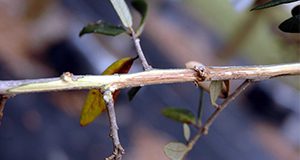
Metsulfuron-methyl, also known as MSM, is an herbicide that is used to control broadleaf weeds and certain grass weeds. It provides effective control of some of the most problematic turfgrass weeds, such as wild garlic, Florida betony, dollar weed, and small Virginia buttonweed. Metsulfuron-methyl is absorbed by plant foliage, so if landscape plants come into contact with the spray or drift they can be injured. This four-page fact sheet describes the potential problems with metsulfuron herbicides, the areas most subsceptible to damage, how to diagnose injury, and how to reduce damage. Written by Chris Marble, Jason Smith, Timothy K. Broschat, Adam Black, Ed Gilman, and Celeste White and published by the School of Forest Resources and Conservation Department.
http://edis.ifas.ufl.edu/fr400
Weed Control for Ornamentals inside Greenhouses and Other Enclosed Structures
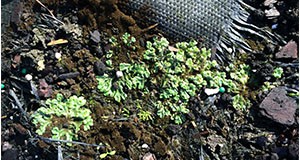
Maintaining a weed-free greenhouse is important for producing healthy and marketable crops. Weeds will compete with crops for water, light, and nutrients. Weeds can find favorable conditions for growth in gravel and along edges, tears, and worn areas of ground cloth. It is important to frequently scout for weeds. This five-page fact sheet describes both chemical methods of controlling weeds, but also non-chemical methods, such as sanitation and prevention, hand weeding, and cultural control practices. Written by Chris Marble and Jeremy Pickens, and published by the Environmental Horticulture Department.
http://edis.ifas.ufl.edu/ep528
Improving Weed Control in Landscape Planting Beds
Because landscape beds often contain a variety of ornamental plants, shrubs, and trees, using herbicides to control weeds in these areas can be challenging; however, non-herbicidal methods can be labor intensive. This 6-page fact sheet outlines how to use landscape design and cultural and chemical practices to effectively control weeds in landscape beds. This publication also discusses the use of pre- and postemergent herbicides. Written by Chris Marble and Andrew Koeser, and published by the UF Department of Environmental Horticulture, June 2015.
http://edis.ifas.ufl.edu/ep523
Biology and Management of Graceful Sandmat (Chamaesyce hypericifolia) in Ornamental Crop Production
Graceful sandmat (Chamaesyce hypericifolia) is a problematic weed that often grows in container media in ornamental plant nurseries. This 4-page facts sheet profiles the biology of graceful sandmat and recommends physical, cultural, and chemicals methods for managing the weed in the nursery environment. Written by Theresa Chormanski, Chris Marble, and Lyn Gettys, and published by the UF Department of Environmental Horticulture, June 2015.
http://edis.ifas.ufl.edu/ep522
Biology and Management of Long-Stalked Phyllanthus in Ornamental Crop Production
This 5-page fact sheet discusses the characteristics of long-stalked phyllanthus and explains how to control its growth in a nursery environment. Written by Theresa Chormanski, Chris Marble, and Lyn Gettys, and published by the UF Department of Environmental Horticulture, April 2015.
http://edis.ifas.ufl.edu/ep518
Biology and Management of Mulberry Weed (Fatoua villosa) in Ornamental Crop Production
This 4-page fact sheet discusses the characteristics of mulberry weed (Fatoua villosa) and explains how to control its growth in a nursery environment. Written by Chris Marble and Shawn Steed, and published by the UF Department of Environmental Horticulture, April 2015.
http://edis.ifas.ufl.edu/ep517
Biology and Management of Oxalis (Oxalis stricta) in Ornamental Crop Production
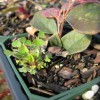 Oxalis grows throughout the year in Florida. It can be found growing in sidewalk cracks, alongside trails, in lawns, flower beds, cultivated fields, and in container nursery stock. In greenhouse studies, oxalis populations have been shown to negatively impact the growth rates of ornamental crops. This 6-page fact sheet was written by Matt Lollar and Chris Marble, and published by the UF Department of Environmental Horticulture, February 2015. (Photo: Chris Marble)
Oxalis grows throughout the year in Florida. It can be found growing in sidewalk cracks, alongside trails, in lawns, flower beds, cultivated fields, and in container nursery stock. In greenhouse studies, oxalis populations have been shown to negatively impact the growth rates of ornamental crops. This 6-page fact sheet was written by Matt Lollar and Chris Marble, and published by the UF Department of Environmental Horticulture, February 2015. (Photo: Chris Marble)
http://edis.ifas.ufl.edu/ep514
Biology and Management of Eclipta (Eclipta prostrata) in Ornamental Crop Production
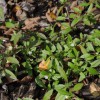 Eclipta grows aggressively in containers and can outcompete nursery crops for water, nutrients, and light. Plants flower in as little as five weeks after germination and produce thousands of seeds over the course of a growing season, and stem fragments left on the soil or media surface following hand-weeding or cultivation can root and reproduce vegetatively. This 4-page fact sheet describes the plant, its biology, and recommendations for physical, cultural, and chemical control. Written by Chris Marble, Shawn Steed, and Nathan S. Boyd, and published by the UF Department of Environmental Horticulture, January 2015. (Photo: Annette Chandler, UF/IFAS)
Eclipta grows aggressively in containers and can outcompete nursery crops for water, nutrients, and light. Plants flower in as little as five weeks after germination and produce thousands of seeds over the course of a growing season, and stem fragments left on the soil or media surface following hand-weeding or cultivation can root and reproduce vegetatively. This 4-page fact sheet describes the plant, its biology, and recommendations for physical, cultural, and chemical control. Written by Chris Marble, Shawn Steed, and Nathan S. Boyd, and published by the UF Department of Environmental Horticulture, January 2015. (Photo: Annette Chandler, UF/IFAS)
http://edis.ifas.ufl.edu/ep512
Biology and Management of Hairy Bittercress (Cardamine hirsute) in Ornamental Crop Production
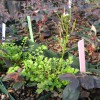 Bittercress commonly grows in the potting media of container-grown ornamentals and often through drainage holes in nursery containers. It also can be a problem in propagation houses, greenhouses, and in the field. This 6-page fact sheet provides species description, plant biology, and management recommendations. Written by Chris Marble, Shawn Steed, and Nathan S. Boyd, and published by the UF Department of Environmental Horticulture, December 2014.
Bittercress commonly grows in the potting media of container-grown ornamentals and often through drainage holes in nursery containers. It also can be a problem in propagation houses, greenhouses, and in the field. This 6-page fact sheet provides species description, plant biology, and management recommendations. Written by Chris Marble, Shawn Steed, and Nathan S. Boyd, and published by the UF Department of Environmental Horticulture, December 2014.
http://edis.ifas.ufl.edu/ep511
Postemergent Herbicides for Use In Ornamentals
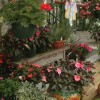 Postemergent herbicides are applied directly to weeds. This 5-page fact sheet is largely comprised of two tables: Table one lists postemergent herbicides that can be safely used over the top of some ornamentals when used according to label directions; table 2 lists postemergent herbicides that are registered for use around ornamental plants when applied as a directed spray. Written by Jeffrey G. Norcini and Chris Marble, and published by the UF Department of Environmental Horticulture, November 2014. (UF/IFAS photo: Thomas Wright)
Postemergent herbicides are applied directly to weeds. This 5-page fact sheet is largely comprised of two tables: Table one lists postemergent herbicides that can be safely used over the top of some ornamentals when used according to label directions; table 2 lists postemergent herbicides that are registered for use around ornamental plants when applied as a directed spray. Written by Jeffrey G. Norcini and Chris Marble, and published by the UF Department of Environmental Horticulture, November 2014. (UF/IFAS photo: Thomas Wright)
http://edis.ifas.ufl.edu/wg059
